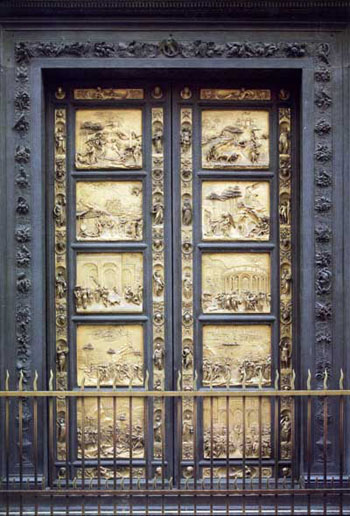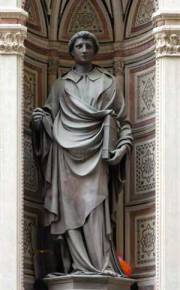Lorenzo Ghiberti was born in Pelago, Italy in the year 1378. At a young age, he received training as a goldsmith and as a sculptor from his father who was an artist and goldsmith. In 1401, he participated in a competition held for the commission in Florence to find an artist to design the north entrance doors of the Baptistery of St. John, also known as the Florence Baptistery. The challenge was to design a quatrefoil panel that depicts the biblical scene of Abraham sacrificing his son Isaac (“Baptistery Dedicated to St. John the Baptist”, 1). Out of all the competitors, the top two were said to be Ghiberti and Filippo Brunelleschi. Ghiberti had an open studio where the public could see his work and provide him their feedback whereas Brunelleschi worked on his models behind closed doors (“Lorenzo Ghiberti’s Gates of Paradise”, 1). Overtime, Ghiberti altered his designs using the public’s criticisms which helped him win the competition. In 1402, Ghiberti was chosen as the winner and he legally took over the commission in 1407.
Although he and Brunelleschi competed against each other in 1401, there is no evidence of the two of them working together. However, artists such as Donatello, Benozzo Gozzoli, and Paolo Uccello worked as young apprentices at his workshop. He also worked with Fra Angelico on Angelico’s Tabernacle of Linaioli painting where Ghiberti designed the marble frame (Kren and Marx, 1). Ghiberti remained and continued to work in Florence throughout most of his life up until his death on December 1st, 1455.
While Ghiberti was still working on the first pair of bronze doors for the Florence Baptistery, Ghiberti was given another commission by the Arte dei Mercanti di Calimala in 1412 to create a life-size bronze statue of St. John the Baptist (“Lorenzo Ghiberti”, 1). Ghiberti finished the statue in 1417 and it is located in Orsanmichele, Florence.
After finishing the bronze statue of St. John the Baptist in 1417, Ghiberti received two other commissions for two large bronze figures. One of them was another bronze figure of St. Stephen, commissioned by the Guild of Wool Manufacturers (“Lorenzo Ghiberti”, 1).
In 1424, the north doors for the baptistery were finally completed after almost twenty years; the doors contained twenty-eight panels depicting scenes from the New Testament of the Bible. After completing the first set, Ghiberti was given a second commission to design the east doors of the baptistery. The east doors were completed sometime between 1425 and 1452 and were later called and named, The Gates of Paradise by Michelangelo (“Lorenzo Ghiberti,” 1).

The Gates of Paradise
Bronze
1425-1452
(replica) Baptistery of St. John the Baptist, Florence
(original) Museo dell’Opera del Duomo, Florence
Since the Baptistery of St. John was considered a central place of worship in Florence, it was important for the baptistery to have a feature facing the Florence Cathedral. After Ghiberti’s completion of the first set of doors, he was the obvious choice to create the second set for the east side that would be facing the Florence Cathedral. The Gates of Paradise consists of two columns of five panels that illustrate scenes from the Old Testament; these ten panels are also surrounded with figures and heads of prophets, also designed by Ghiberti (“The Gates to the City”, 1). The top left panel depicts the creation of Adam and Eve, as well as their banishment from the Garden of Eden, with the following panels each depicting different narratives. The second panel for example, portrays the scene of where Adam and Eve’s son, Cain, murders his brother Abel. The third panel shows Noah’s story with various animals stepping out of his ark, while the fourth panel shows the impending birth of Isaac. The fifth panel shows Isaac’s son, Jacob, posing as his older brother Esau in front of his nearly-blind father to try and claim Esau’s inheritance. The sixth panel depicts the story of when Joseph is revealing his identity as the governor of Egypt to his brothers who sold him into slavery as a child, while the seventh panel depicts the scene of Moses receiving the Ten Commandments from God. The eighth panel shows Moses’ successor, Joshua leading a group of Israelites across a miraculously dry Jordan River to Jericho; the ninth panel portrays David’s defeat of Goliath, while the tenth and final panel shows King Solomon receiving the Queen of Sheba at his court (“Lorenzo Ghiberti’s Gates of Paradise”, 1).
On each of the ten panels, Ghiberti is able to show multiple narratives within one panel by using scale and grouping figures together across the composition. For example, on the ninth panel that shows David’s defeat of Goliath, the figures on the foreground, which show David decapitating the giant with his sword surrounded by the Israelite army, are much larger than the figures on the top background that depicts David bringing Goliath’s head to Jerusalem. This contrast in the size of the figures is also shown on the eighth panel that shows the story of Joshua; this panel also illustrates Ghiberti’s use of rhythm as the figures on the foreground are facing the right side, whereas the ones on the top background, a scene showing Joshua and the Israelites marching around Jerusalem, are all walking to the left. Curves and lines are also used to show the crumbling of the Jerusalem walls, adding texture to the scene.
Ghiberti’s creation of the second gates shows how he reinvented the practice of casting in bronze. He employed the newly discovered principle of perspective to give depth to his compositions as well as to show features of Italian Renaissance art such as realism and highlighting the emotions of the characters in the Biblical scenes (“The Gates of Paradise”, 1). Ghiberti’s use of texture and multi-level relief allows the figures to appear more life-like and the three-dimensionality on the panels makes it seem as if the people in the scenes were frozen in time (Reznick, 1). At the time of the gates’ creation, it was innovative of Ghiberti to cast something of that stature. Annamaria Giusti, the director of the Museo dell’Opificio delle Pietre Dure, stated that before Ghiberti, nobody in Italy had created anything close to a three-ton bronze piece since the end of the Roman Empire (Lubow, 3).
When it comes to looking at the individual panels of the gates, many have claimed that Ghiberti’s panel that tells the story of Jacob and Esau expresses the Renaissance aesthetic more than any of the other panels (“Lorenzo Ghiberti’s Gates of Paradise”, 5). The proportioned halls and pavement of Isaac’s house help create a linear perspective to construct the narrative, arranging the episodes of the story and placing the figures around a vanishing point that is framed by the central arch on the panel (“The Gates of Paradise”, 1). Through the use of three-dimensional figures and depiction of architectural structures on bronze, not only do the scenes on the gate panels appear more life-like, but Ghiberti also shows how he can successfully incorporate the art of storytelling through his creation.
Works Cited
“Baptistery Dedicated to St. John the Baptist.” Visit Florence. n.d. Web. 29 Jul. 2013.
Ghiberti, Lorenzo. St. John the Baptist. 1416. Orsanmichele. Italian Renaissance Art. Web. 6
Aug. 2013.
Ghiberti, Lorenzo. St. Stephen. 1428. Orsanmichele. Italian Renaissance Art. Web. 5 Aug. 2013.
Ghiberti, Lorenzo. The Gates of Paradise. 1452. Florence. Italian Renaissance Art. Web. 5 Aug.
2013.
Haber, John. “The Gates to the City.” Haber Arts. 13 Jan. 2008. Web. 29 Jul. 2013.
Kren, Emil and Marx, Daniel. “Linaioli Tabernacle.” Web Gallery of Art. n.d. Web. 5 Aug. 2013.
“Lorenzo Ghiberti.” PBS. n.d. Web. 29 Jul. 2013.
“Lorenzo Ghiberti’s Gates of Paradise.” Alpha Net Design. n.d. Web. 6 Aug. 2013.
Lubow, Arthur. “The Gates of Paradise.” Smithsonian. Nov. 2007. Web. 29 Jul. 2013.
“Renaissance Art.” The Italian Renaissance. n.d. Web. 5 Aug. 2013.

